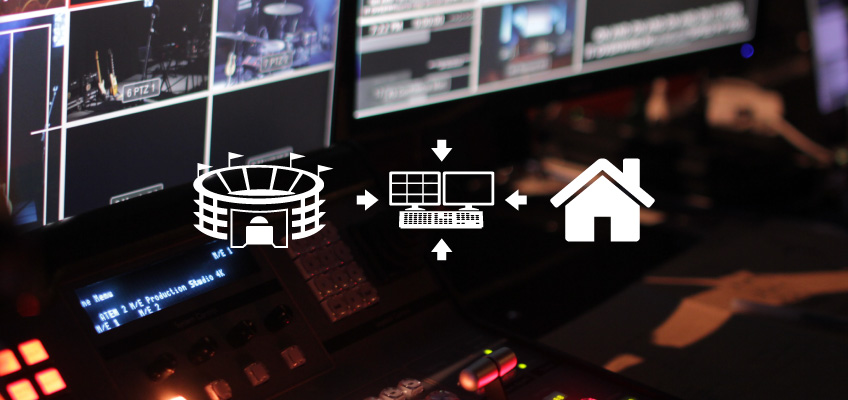As technology evolves and trends shift, so do the terms used in broadcast. And in 2020, some video streaming technology, and associated terminology, has skyrocketed in popularity; in particular, remote production, decentralized production, and at-home workflows.
However, as these phrases are used more often, they are sometimes confused or used interchangeably.
In this post, we’re going to give a brief explanation of remote production, decentralized production, and at-home workflows, touching upon their similarities – and their differences.
Remote Production
Remote Production is also referred to as REMI (Remote Integration Model.) It is a broadcast workflow in which content is captured live at one location, while production is performed at another, often times a main studio.
This often means that content being captured at a stadium is being produced in a studio a few or many miles away, instead of in an on-site studio or OB (Outside Broadcast) truck.
Remote production has been used for a number of purposes in broadcast video over the years, especially news and sports events where building a full production suite on location is not reasonable. Advances in video streaming technology has also made remote production more accessible than ever before; most venues have broadband internet connections, meaning that expensive satellite links are no longer required. And in 2020, remote production, especially over IP, has been more widely deployed than ever before as a measure to limit any risks to staff and to adhere to local venue health and safety policies.
Decentralized Production
Decentralized production is a type of remote production workflow – the key element that distinguishes decentralized production is that production does not take place within a single facility or office, but from a variety of locations. It is also referred to as distributed production. This could mean different production facilities, separate master control rooms or even across multiple home-based studios, depending on the workflow in question.
Decentralized production has become especially popular in 2020, as more people have taken to working from home and broadcasters have tried to minimize the staff coming into their physical studios. Decentralized production also allows content to be sent to multiple studios, each with specializations, which again, can reduce the amount of staff required in one particular location.
It is particularly important that video streaming technology used for decentralized production is as low latency as possible so that producers, broadcast engineers, and executives are able to work with live content in real-time. Low latency contribution feeds also need to be low latency as the final production need to pass through several locations across the workflow before being broadcast.
At-Home Workflows
Traditionally, at-home contribution has been synonymous to the REMI model where local event contribution streams are sent to a main broadcast (“home”) facility for production. However, the production side has become increasingly decentralized with producers working at home.
Which is why, in 2020, the term “at-home” for broadcast workflows has evolved; it is less frequently used to indicate traditional REMI workflows, but more for decentralized production workflows, with producers working from home.
At-home production within the context of a decentralized production workflow, is where audio engineers, switchers, and closed caption specialists, work from their homes. The video feeds are sent through to their home, where each member of the team does their part to refine the content before sending it back.
What Kind of Remote Production Solution Do I Need?
Regardless of the type of remote production workflow you are using, decentralized, at-home, or from a venue to a studio or from home, there are some key elements to a good remote production video solution. It should be low latency, high quality, and able to adapt to changing or unreliable network conditions. Fortunately, Haivison’s video streaming solutions for remote production meet all of these needs.

